Menus
- 3 cylinders in line, 1215 cm3, 141 hp at 9350 rpm, 122 Nm at 7600 rpm, 243 kilos dry, from € 19,950
- Less weight and more techno for the big road trail from Triumph
- Discovery
- In the saddle
- Engine and transmission
- In the city
- On motorways and main roads
- On departmental
- Part-cycle
- Brakes
- Comfort and duo
- Consumption & autonomy
- Conclusion
- Video test of the Triumph Tiger 1200 XRt
3 cylinders in line, 1215 cm3, 141 hp at 9350 rpm, 122 Nm at 7600 rpm, 243 kilos dry, from € 19,950
Less weight and more techno for the big road trail from Triumph
There are no more seasons, my poor Lucette! Frankly, it makes life difficult to go to the great south of Spain and it’s the deluge. The horizon is blocked, it’s raining in buckets, it’s all sticky on the asphalt and the tires make a rubbery sucking noise while we roll over eggs. It’s all rotten, I hate it.
After such an introduction, you must think that I asserted my right of withdrawal and that I stayed under the covers, rather than going to risk my life in such conditions. Nay! Not because I have a professional conscience, but because in fact these conditions, they are downright awesome! Eh yes. Quite simply because the trails are superior to any other category of bike, not that they let you show off like you have a big SUV, but that they really show up when the conditions are rough. Normal, in fact: these machines which sell you dreams and which make you promises of the end of the world, they must never give up to live up to their reputation and power, finally, reveal all their potential.
So, so much the better that the conditions are difficult: who can do more, can do less. And this new Tiger 1200 can do a lot: Triumph offers no less than 6 different versions, 4 on the basis of a road orientation (the XR, with R for Road, with stick wheels) and 2 on a more promising versatile, the XC (C for Cross, with wire wheels). So that’s one version less than in the last two years. Two years ? Yes, it’s only been two years since Triumph updated its big trail and we tried it on the roads and tracks of Portugal. Things have happened in two years in the trail world and Triumph wants to continue defending its interests there..
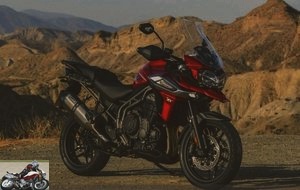
However, this is more of an evolution, certainly in depth, than a real revolution. On the program for 2018: more techno and less weight. Nevertheless, to understand the machine in its entirety, we encourage you to (re) take a look at the test of its latest generation of Tiger 1200 Explorer 2016. The 2018 range now starts at € 15,950 with the XR.
Discovery
Everything changes, nothing changes? It is true that for an observer unfamiliar with the evolutions of Triumph’s flagship, distinguishing novelty is a bit like playing the game of 7 errors. In detail, we can see that the color palette changes (it is quite varied in absolute terms, but the colors are often specific to the different versions, which must be a headache for dealers to order and manage stocks. ): in the case of our top-of-the-range version with a road trend, the XRt is white or red, as desired. Looking into the details, we can see improvements on the badges and logos, more qualitative, as well as on the engine housings. Nevertheless, here is a clue that can hit the mark for sure: the new sports LED lights with "turn" function, as well as a new fully digital TFT 5-inch diameter dashboard, which here has 6 modes. different displays, divided into two themes (and even 12 if we count the fact that they have day and night lighting). Admittedly, the range of Tiger 1200 XR being complex, the endowment varies according to the models and the "base" XR is satisfied with an LCD dashboard..
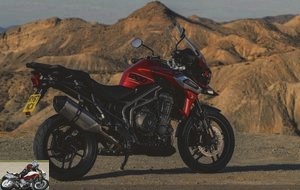
Another distinctive feature is the standard Arrow exhaust silencer (in titanium and carbon fiber), which is responsible for a weight reduction of 2.1 kilos compared to the previous exhaust silencer. The other versions of the XR keep a standard exhaust, but one which is new and which has slimmed down by 325 grams. It is always that taken! Because Triumph heard the criticisms on the previous version of the Tiger 1200 Explorer and which concerned the weight. The news is no longer called Explorer, that is symbolic lightness. On the other hand, a lot of work was done to thin the machine wherever it was possible. Sometimes it shows: the new fog lights have lost 500 grams, the battery downright 2.6 kilos, the magnesium crankcases, 300 grams, the crash bars around the engine, 1.3 kilos and the engine guard. 500 grams. And sometimes it doesn’t show: the new crankshaft is 500 grams lighter and the engine flywheel has lost 2.5 kilos. Thus, depending on the version and the level of equipment, the weight gain ranges from 2 to 11 kilos, the maximum concerning our trial version, the XRt..

That said, Triumph does not skimp on the equipment: because on the handlebars of this machine, all that is missing is the rear view camera to compete with a Porsche Cayenne or a posh SUV of the same kind. Obviously, what I’m talking about here concerns the top-of-the-range XRt version, but we have the total, with driving modes, semi-active suspensions, heated grips and saddles, cruise control, complex dashboard, it is palace, no ?
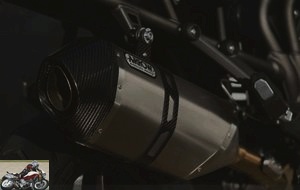
In the saddle
The weight may have been reduced by 11 kilos, there are still 243 (dry), plus 20 liters in the tank, the whole being high placed. In fact, the Tiger 1200 remains a wide, tall, bulky, intimidating, and heavier machine by comparison than a BMW GS. However, we quickly realize that its balance is astonishing and that the softness of the controls combined with the goodwill of the three cylinders ultimately makes it quite easy to handle, but all the same, the puny fraction of the motorcyclist sphere will be able to , rightly, go his way.
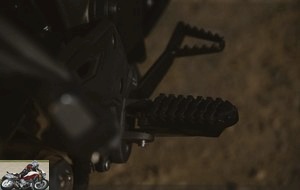
Once on board (the saddle is adjustable between 835 and 855 mm – and let us remind the courts on legs that the XRx LRH version can have a saddle at 790 mm, which is 45 mm lower than before), we can see everything following the merits of this novelty, via the dashboard and its TFT panel, clear and readable, once the little adaptation time has passed, which consists in understanding how the menus work. Thanks to a main button on the right stalk, then a multidimensional trigger on the left stalk, all adjustments and configurations are easily done and the fact that these stems are backlit is a good thing for night driving. In addition, there are shortcuts for the driving modes. The heated grip button is easily accessible. The high bubble is electrically regulated; its dimensions are unchanged from the first version. We will quickly realize that it protects really well. The handlebars have been moved forward 20mm but the riding position remains very natural.
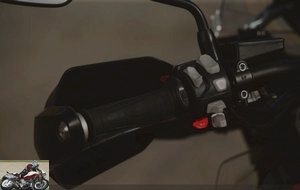
Another novelty, appreciable: the keyless starting system.
Engine and transmission
If the torque is identical and the power climbs by two small horses (from 139 to 141 hp, at 9350 rpm), the three-cylinder has however changed a lot, in particular through a new crankshaft and a flywheel. inertia lightened by more than 2 kilos. If it is still as elastic, with in particular a fairly flat torque curve, it still has its small character and begins to seduce by its goodwill, which will be appreciable in the context of tourism use..
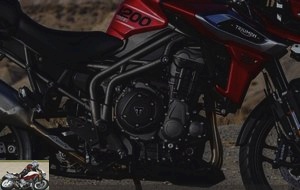
For example, it is quite flexible, even if it is a bit reluctant to pick up below 50 km / h in 6th gear. Then, it gives the feeling of being always available, but we see on the motorway that the times in the last report at 120 km / h (a little over 4,500 rpm in sixth) are not phenomenal, while by its cubic capacity, its power and its architecture, we expected instantaneous hyper-space. In fact, it is rather above 145 km / h on the last gear that it starts to send seriously. In fact, in a tourism use, in a duo with luggage, we may find, not without astonishment, that a little lack of resources with the usual paces and regimes. And this, even with the cartography on "sport".
That said, this engine has another strength: depending on the driving modes, it responds in a differentiated way and despite everything reveals a beautiful character and a beautiful extension, in "sport" mode, above 6000 rpm, with in more a deep sound, which wakes up a little.
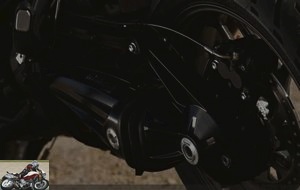
The gearbox is still 6-speed and the final transmission is by cardan shaft. However, we note the arrival of an up & down shifter. A good idea even if, in fact, we still feel a certain slowness and the presence of a gimbal is not forgotten. As a result, it is more readily used when downshifting, while in normal use, the use of the clutch does not appear to be heresy..
In the city
Let’s be frank: few cities on this test and in addition in Almeria, which is not worth the Parisian nightmare carefully orchestrated by the Town Hall. We note despite everything that the turning radius is good, that the balance is satisfactory, that the engine is flexible enough to cruising at a hair over 2000 rpm in fourth on the boulevards. During maneuvers, the weight remains present…
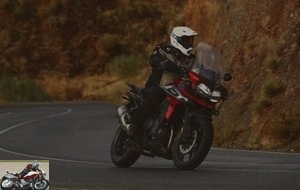
On motorways and main roads
The Tiger 1200 XRt is here in its element. Despite everything, we first note excellent protection: while I did this whole test with a cross helmet and halfway in the rain, I stayed dry around the neck, with few raindrops. embedded in the interstices of the helmet and the mask and I remained perfectly waterproof throughout the day.
Then, we note the good level of comfort of the suspensions, with despite everything notable differences in softness according to the settings, which can be refined manually between "comfort" and "sport" and which is also positioned according to the driving mode chosen. . We did not have time to tease the maximum speed, but around 180 (perfect in Germany, at 7000 rpm cruising, or 3000 rpm from the red zone), the Tiger 1200 devours the distances. . In France, we will be satisfied with a small 5000 rev / min in 6th (130 km / h), it is wiser. Especially since when the storm rises, the strong frontal surface of the machine makes it sensitive to side wind..

On board, it’s a palace. Between the heating and the cruise control, the kilometers pass serenely failing to provide fun. On the other hand, we had already criticized the old model for a saddle a bit hard. The news inaugurates a new material, but the defect remains. Alas. Note, however, that the cruise control interface has changed, for greater ease of use..
On departmental
From the departmental, we did almost only that. A lot in survival mode (ah, the grasmouille, ah, the entrances to bends on banks of dead leaves!) And a little bit in pleasure mode, on a climb up the pass in the dry with an opener that unpacks. Perfect for capturing both sides of this bike’s personality.

In survival mode, therefore: we appreciate the general smoothness of the kinematic chain, the three cylinders which has a beautiful extension and which can save a change of ratio between two turns, the "rain" mode of the mapping which Effectively gives a smoother response to the throttle and a bike which, in the end, remains very healthy and rather easy, which allows to ride on low-grip asphalt without stress. In this sense, the Tiger 1200 remains a trail because, despite everything, we keep a relative lightness of mind on the handlebars, while with travelers from other families, like GT or custom, we would be much more on our guard, prisoner of weight and less intuitive geometry. Finally, while cruising at 3500 rpm in 6th on the last gear at 90 km / h, the Tiger 1200 purrs smoothly.
In the dry, another observation. First, by following an opener who knows his job well, we see that we can enter a bend frankly with a solid and straightforward front end. Of course, the weight is never really forgotten and you should not hesitate to work it on the handlebars to make it turn, but the pace is starting to be quite generous. Then, braking ensures and despite the high suspension travel, mass transfers remain contained, which helps to forget a little the mass of the machine. We forget a little, this mass, but not totally, because if the efficiency is there, at no time do we feel this little spark of madness, this fun side that makes you definitely consider that the trails are the best bikes in the world. world. There, we send steak, we spread with application and it is effective; it’s already that.

The engine is expressed well in the revs with a copious extension above 6000 rpm (the third will break a little above 165 km / h, which is sufficient for use on secondary roads, right?) . The box accepts a slightly more sporty handling, the brakes ensure, that the good. In this context, however, we would have appreciated a slightly more communicative Arrow silencer, with some nice backlashes when decelerating and more intense roaring when you stay welded, gas in full…
Finally, at night, there is no doubt that the adaptive lights with turn function will be useful, although we were not able to test their effectiveness on this test..
Part-cycle
Strong and techno, such is the credo of this machine. Strong because around a tubular steel trellis frame, Triumph has hung on this bike a solid inverted WP fork with 48 mm in diameter and 190 mm of travel, while a WP mono-shock absorber officiates at the rear with a travel of 193 mm. Special feature of the system: semi-active suspensions. Not only are they configured differently depending on the driving mode, but in addition, via the on-board computer, we can refine their operation on an axis ranging from "comfort" to "sport" through "normal".

Another particularity of these suspensions: the automatic detection of the load. Thus, if, during your trip, dazzled by your presence, you catch a Geraldine with some luggage, its presence will be detected in less than 5 seconds by the machine which will automatically adjust the preload, whereas on some competing machines, you will need to enter a menu on the on-board computer, select the "Geraldine with luggage" function.
Semi-active suspensions have also evolved in that they act on all driving phases: thus, on heavy braking, the rear shock absorber will slow down the rebound a little, in order to better contain the attitude movements and to stabilize the motorcycle.

As for the tires, we are on the Metzeler Tourance Next in 120/70 x 19 in front and 170/60 x 17 behind; a ride that has given satisfaction with its precision in the dry and its ability to land smoothly in the wet.
Brakes
Brembo monobloc radials on this machine, which pinch 305mm discs up front, the rear being entrusted to a 282mm disc, clamped by a 2-piston Nissin caliper. Braking is coupled, with a combined action on the rear when you take the lever. Triumph has fitted new pads this year, for a better feeling. At no time during this test did braking arise as a problem: power, dosage, everything is fine..

Comfort and duo
Here is another argument of this machine: its space on board, the width of the saddles, the excellent protection (you can therefore ride for a long time under the fleet while remaining dry), the equipment (saddles – including passenger – and handles heated, adjustable bubble), the natural driving position: everything helps you feel good, especially as the comfort of the suspensions ranges from relatively firm in "sport" to much more accommodating in "comfort". Everything is fine, therefore, which makes all the more regret that the rider saddle remains a little firm.

Consumption & autonomy
We finished this test, carried out half by winding in the wet and half by putting a little more gas, with an average consumption of 6.1 l at the on-board computer. The tank has a capacity that has not changed: 20 liters. We therefore have a little more than 300 km of autonomy. The presence of a fuel gauge and an autonomy indicator on the dashboard are appreciable.

Conclusion
Serious and techno: this is how to classify this Tiger 1200 XRt. Because of the trails, there are light, frivolous, athletic, versatile and others who are struggling to assert themselves. The Tiger 1200 XRt will appeal to those who are looking for a statutory and rewarding machine. Enhancing, it is, by the care given to its new finish, by its LED lights, by its TFT dashboard, by its complete control units, which testify to an electronic package at the forefront of the category and which allows Triumph to assert that despite the price of the machine, which is therefore, the Tiger 1200 XRt is much more advantageous than its competitors who are either much more expensive, or require you to compensate for a stingy standard endowment with blows of packs that seal the final invoice.
The Tiger 1200 XRt is typically a big wheeler machine: ultra complete equipment, high level active safety, ability to configure the bike according to use with a real impact on its engine and chassis operation, royal protection, there is everything here what you need to swallow the bollard, including an engine that only drains every 16,000 kilometers. And it is in these conditions that the most powerful of the 1200 cardan trails will really prove to be….

Strong points
- Very good road
- Rather easy to get started
- Complete and readable dashboard
- Good ergonomics of all functions
- Balanced chassis despite the weight
- Good protection of the screen and aero appendages
- State-of-the-art techno equipment and staffing
- Efficient suspensions
- Engine character in the revs in Sport mode
- A serious and efficient vision of the road trail
Weak points
- Weight still high despite technical developments
- Repeats in 6th
- Saddle still a little firm
- Shy tone of the Arrow pot
- Sensitive to side wind
The technical sheet of the Triumph Tiger 1200 XRt
Test conditions
- Route: 230 kilometers in the Sierra Nevada, near Almeria (Spain), half in the rain
- Motorcycle mileage: 1600 km
- Problem encountered: a small fault with the ABS at the end of the day, then it got back to normal
The competition: BMW R 1200 GS Executive, Ducati 1200 Multistrada S
Video test of the Triumph Tiger 1200 XRt
Related articles
-
Triumph Street Triple S A2 test
The turbulent English roadster in its version intended for young drivers 3 cylinders in line, 660 cm3, 48 horsepower at 11,000 rpm, 60 Nm at 5,100 rpm,…
-
A renewed proposal in a category of “mid-size” trails in full expansion …. 3 cylinders in line, 800 cm3, 95 hp at 9,500 rpm, 79 Nm at 8,050 rpm, 208…
-
3 cylinders in line, 1215 cm3, 141 hp at 9350 rpm, 122 Nm at 7600 rpm, 248 kilos dry, from € 21,150 This variation of the Tiger 1200 family is intended…
-
Flat twin, 1170 cm3, 125 hp at 7,750 rpm, 125 Nm at 6,500 rpm, 244 kilos with full tank, from € 16,400 The world’s best-selling large displacement is as…
-
Triumph Speed Triple RS test
British icon returns sharper than ever 3 cylinders in line, 1050 cm3, 150 hp at 10,500 rpm, 117 Nm at 7,150 rpm, 189 kilos dry, from € 15,850 Remember:…
-
Triumph Tiger Explorer XCa test
One goal, the a (d) venture, 7 ways to achieve it A substantial technological revolution masked by a rather timid relifting. During a press conference…
-
Triumph Speed Triple 1200 RS motorcycle test
Madame More 3 cylinders in line, 1160 cm3, 180 hp at 10,750 rpm, 125 Nm at 9,000 rpm, 198 kg in running order, from € 17,500 Each time a new product is…
-
Triumph Tiger 955 motorcycle test
In order to respond present in all categories, Triumph presented in 1993 a big road trail, XXL version: the Tiger. Powered by a 3-cylinder 885 cc…
-
A wilder tiger Tiger! In 20 years, the Triumph trail has changed dramatically. From the imposing Tiger 900 trail, which appeared in 1993 at the Cologne…
-
Triumph Rocket 2300 touring test
Welcome to the club !! (Editor’s note : in 4 words !! ) A couple of years ago I had the opportunity to run in one of the first Rockets 3 releases on the…
Black swirl as those who indulge in detailling say. In fact I was thinking of clothes
I have one. Generation before facelift, so the same
2-3 details The passenger saddle only allows the duo in recovery, it is a piece of wood. A few movements of the handlebars on strong acceleration out of a curve, never tricky but it moves a little. The autonomy is a fair treat, like all current roadsters if we are really having fun we are in reserve at 170-180 max, see less if we unplug everything.
it works really hard and much better than the old one above 7000. Below it is the same big hand pushing.
Oh by the way, the tires are Power 5, 2CT + it is the type of rubber, not the reference of the tire 😃
And presto, bonus video!
I find it not bad .. apart from the front headlight obviously, which you may have to get used to ??
Its strong point remains the engine. It looks a bit slappy to me on bumpy back roads and not great for the passenger in my opinion.
An interesting little toy for a relatively fair price.
Thank you for this very complete technical presentation. The motorcycle is also and above all the use that we make of it and the landscapes that we can thus discover. So what is this beautiful place in France that I failed to recognize ?
Bozzard.
Unbeatable price for the package, unfortunately it is at the price of the finish it seems.
Still, it is definitely a reference of the mid size at a more than competitive price, Yamaha offers here a solid product.
Performance price to be compared with the perf 243 for 90 km / h! In which country can you drive without limitations? None especially not in Germany, where areas are limited in space … if not 120, so what good is the vulgum pecum?
The optics we like or not but it is fairly well integrated into the bike, on the other hand the exhaust … I can’t find the words … Before we changed the exhaust mainly for the noise but it will be for the ‘aesthetic…
The Street Triple R has an up & down shifter as standard contrary to what is stated in the article.
On the Street Triple R the shifter is UP only … and that’s a big difference.